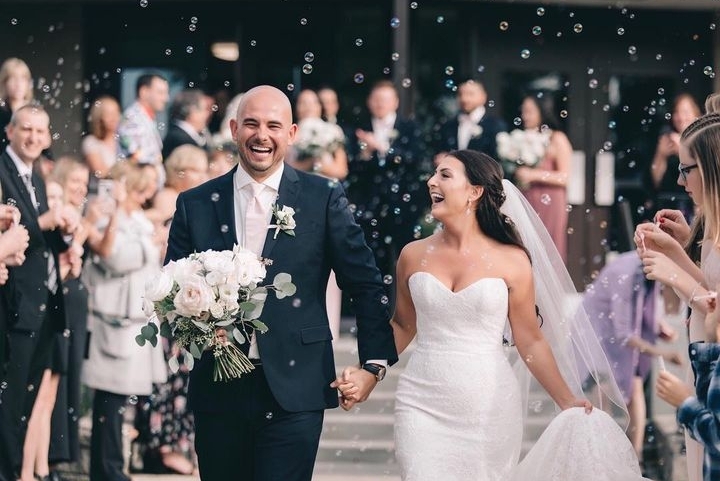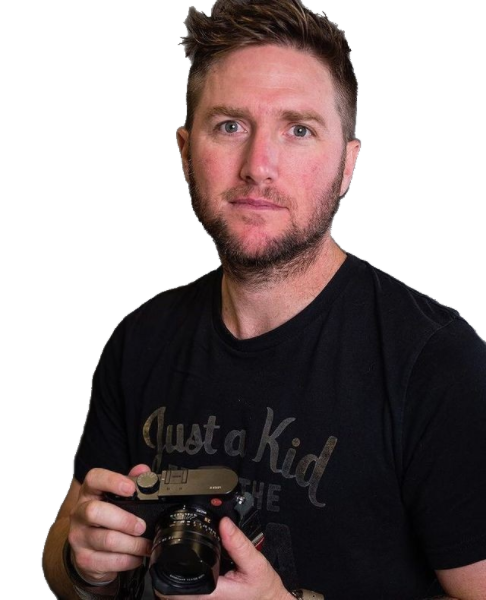Last Updated on January 22, 2024 by Sharon Advik
In today’s article, I want to share how I photograph a wedding using only prime lenses.
I photograph with a wide variety of prime lenses, and if you’re wondering why I don’t use a zoom lens rather than a whole bunch of prime lenses, there are a few reasons.
So, first of all, I love the low-light capabilities of prime lenses.
Another reason is that prime lenses generally have a better quality in their photos.
The prime lenses do have excellent quality.
The bokeh is beautiful, the sharpness is crips, and I love using prime lenses.
One less reason I love using prime lenses is that prime lenses help me stay creative throughout the day.
So these are my favorite 5 prime lenses for wedding photography, which I love to shoot with throughout the wedding.
Which are the best prime lenses for wedding photography?
Here are my recommended top 5 best prime lenses for wedding photography:-
Canon 85mm F1.2: (Best Canon prime lens for wedding photography)
So, considering this lens, I think you should consider the size and the price.
The size of this thing is massive.
When I attach this lens to the Canon art camera, it makes it very top-heavy.
Although it is very large, I don’t find it too heavy to handle when shooting with my art.
With the Canon RF lens mount, you get faster autofocus and communication between the body and the lens.
So when I shoot weddings with this lens, it is a must; it is fast in autofocus.
Another thing to consider is that this is a prime lens, so it’s 85 millimeters, so you’re stuck at 85 millimeters. Mount is only suitable for the Canon mirrorless system.
One of this lens’s most fantastic features is the front control ring.
I use this control ring to control my ISO, so when I used this lens for this wedding, it was super quick, and autofocus was a breeze, picking up where I focused with the Canon Art.
This was incredible; the colors, contrast, and overall picture quality were much better.
This is a must if you’re getting into prime lenses like myself for weddings.
As I mentioned, this is F 1.2, and, incredibly, the sharpness is out of this world.
The bokeh in the background is beautiful, and no chromatic aberration is happening.
The Canon 85 1.2 is just absolutely insane.
Canon 50mm F1.2: (Best 50mm prime lens for wedding photography)
It is big and heavy; it is not a nifty 50.
However, it’s worth it because of the image quality, the razor-sharpness wide-open at 1.2, and the overall color rendition of this lens.
So, let’s jump into more detail about why I think it’s worth it.
But let’s start with just this guy’s overall appearance and size.
It is huge, is not a small 50-millimeter lens, and is not a nifty 50 by any standard.
When I first got this, it turned me off because of the huge size; obviously, having the grip on the ASR makes it feel better in my hand.
However, it’s still usable without the grip, especially with the ASR, because it is so good.
The appearance of this guy builds quality-wise; it’s pretty solid.
I know that some people are not fans of the plastic outer coating that the lenses have; I love it; it’s kind of like tough plastic.
So I think that’s welcome in this is a weather-sealed.
I shoot both photos and videos for weddings for commercial work.
My absolute priority with any lens is autofocus: Is it quick and accurate?
The lens performs well; I don’t think it’s the fastest I’ve ever used.
However, it’s fast enough for all my wedding use cases.
As I’m a pretty quick shooter, I like to get in, pull the camera up, roll off a couple of shots, and then move, so I do not want this camera’s autofocus to be better with the RF system.
It just feels good. It’s snappy.
I usually use a single shot or an Fs, but then we’ll switch to servo with four photographs of a bride and groom walking towards me or somebody walking towards me.
That’s typically when I switch to continuous or servo autofocus. However, to be sincere, this lens’s internal focusing element moves.
The next thing is image quality, which is where this lens shines.
I was amazed when I saw attack sharpness out wide open at 1.2 on the subjects’ eyes.
I was blown away by how razor-sharp that was.
Also, the out-of-focus renderings, the bokeh in these images, are soft and pleasant.
Some lenses have out-of-focus renderings that aren’t as pleasant; this one is so buttery smooth, and I love it for that. I’m not a huge bokeh maniac.
My experience so far has been nothing but good with this lens; it inspires me to shoot with it, which makes me shoot more with it.
I hope that gives you a good idea of flair, how sharp it can be, and various settings, maybe studio outdoor.
It’s just a versatile lens.
I started my photography career with a single camera and 50-millimeter 1.2 lenses.
It is a versatile focal length for shooting events, portraits, and anything else.
It’s good enough, and the image quality is excellent enough that it is worth using and purchasing.
Canon 35mm F1.4: (Best prime lens for wedding photography)
I used to own that one and shot with it for about 3 years, so this lens was a massive upgrade.
And I want to go into a couple of reasons why this lens was a huge upgrade.
One of my favorite things about this lens is its ability to shoot at 1.4; it’s still sharp in that setting.
This allows me to go down if there’s a messy background and get rid of some of that stuff in the background but still have lots of context with the longer focal length.
Another thing I love about this lens is the ability to frame in the corners, so I like creative framing.
I don’t like to dissenter people a lot.
I like to have them off to the side or at the bottom, so this lens allows me to do that without getting a considerable penalty and corner sharpness.
So, I’m not constantly thinking about the center and getting that sharpness when framing.
Another considerable advantage of this lens compared to the old version is that there’s hardly any distortion.
So you get an adorable frame; if the lens has a lot of distortion and you’re crushing it in Lightroom, the corners get even less sharp.
And for family formals, where you’re putting people on the sides, you want to fill that frame for at least an 8/10, and I found this lens was perfect for that.
When I’m doing a photo, I usually look for the backlight unless it’s like Twilight or The Golden Hour.
Because this will be a much more flattering picture, we won’t have those harsh shadows, and people’s eyes won’t water.
So I constantly shoot backlit and don’t get any chromatic aberration background with this lens.
Canon’s BR lens element removes much of that chromatic aberration, which saves me time in post by not requiring me to correct it.
The backgrounds look likable, and there’s more resolution; you’re not losing resolution to weird lens defects, so this guy has a massive advantage.
In conclusion, this is my favorite Canon lens.
You get even a little more resolution and starboard 1.4; you still get those nice cannon colors.
I’d say this lens. If you’re a working professional, this is pretty much a must-have.
I don’t have one, but I would never want to go to a wedding without this lens.
If you’re a prime shooter like me and know it is your full-time job, I think this is an excellent investment for any working professional.
Sony 50mm F1.8: (Best Sony prime lens for wedding photography)
The 50 millimeters 1.8 OSS is one of the best lenses with a wide aperture in the IPC range; I will give you five reasons why.
I’ve used this lens for quite a while now with my Sony A6000, and it’s just one of those lenses that I repeatedly choose for portrait shots.
Firstly, the 50-millimeter lens has one of the best features you need when filming on the A 6000, which always says optical station.
As you may know, the A6000 doesn’t have fibers, which is tough for video users.
It’s not too bad. The fibers allow photographers to use slower shutter speeds, capturing more light.
They bump up that ISO to compensate for their low light.
In video work, it makes an incredible difference with OSS found in most markets.
Holding the camera steadily smooths out, giving a much smoother, steadier-looking image, which can make the difference between an amateur and a professional-looking shot.
But paired with a gimbal, you will get incredible cinematic footage out of this lens.
Secondly is the price; this lens is the cheapest autofocus with OSS on the market.
The beauty of having an APS-C camera is that the lens is much cheaper than the Full Frame Options.
It’s fantastic because you have more money in your pockets.
You have more money to spend on accessories you might need, such as ND filters, gimbals, tripods, or anything else; this lens is excellent because of its focal range.
It’ll vary from person to person in the focal range, but this is a 75-millimeter equivalent.
It’s perfect for portraits and situations where you don’t want to get too close to the subject.
This is incredibly significant for gimbals; you can also purchase smaller gimbals, which are generally cheaper and much easier to carry around.
The negative side to full-frame is that the lenses are generally bigger and heavier, the body is significant in a bigger gimbal, and it is too heavy to carry around.
Lastly, the 50-millimeter lens is sharp, even at a wide aperture of 1.8; this thing is incredible.
Stopping it down to 2.8 and f4 produces incredibly sharp images with decent background compression or bokeh.
There’s a little vignetting in the corners as check at the center sharpness in the center and corners.
It’s nice and sharp in the center, with high contrast but a bit of chromatic aberration in the corner.
Overall, the Sony lens performs fantastically, so if you’re looking into getting an excellent Nifty 50 lens, this one is a must.
It would help if you got this lens.
Nikon 20mm f1.8: (Best Nikon prime lens for wedding photography)
The Nikon 20mm, f1.8 Prime lens for Wedding Photography will be the best and ideal choice to buy your first or second prime with a more professional function.
This award-winning lens is the best Nikon Prime available for wedding photography.
This prime lens for wedding photography is a favorite in the industry because of its wide aperture, and experts have claimed it is best for most fashion shoots.
Its f/1.8 maximum aperture lets you shoot without a flash in dimly lit situations and offers close focus capability.
So you can capture every detail with a stunning background blur that creates an emotional connection with your subject.
This lens has a sleek, elegant, yet durable design to handle whatever is thrown at it on big days like weddings.
This small, wide-angle setup will benefit wedding photography, as it gets you close to your subjects while maintaining the headroom needed to work quickly on crowded dance floors.
Its versatility in sneaking up on subjects without being noticed makes it an ideal choice when you need something that will not distract other guests from your day but will still capture every detail.
This professional wide-angle lens shoots high-quality imagery without sacrificing image quality or versatility.
Ditch the blurry group pictures and give your clients sharp wedding portraits with this Nikon 20mm f1.8 prime lens!
It’s also Nikon’s fastest wide-angle, with a maximum aperture of f/1.8 that allows for dramatic nighttime or low-light images that would be impossible without high-aperture lenses like this one.
This lens features ED glass elements and a Nano Crystal Coat throughout the optical system for more precise image quality.
I ensure you never miss a moment, even when shooting under low light or mobile conditions!
When you’re shooting weddings, it’s all about capturing the moment as beautifully and creatively as possible.
And with this prime lens for wedding photography, you can do just that!
The Nikon 20mm f1.8 prime lens is considered one of the best performers in its class for wedding photography.
Discover the uncompromising performance of this Nikon prime lens today!
CONCLUSION:
Alright, guys, that concludes all the lenses we will discuss today in this article.
Do you guys have any experience with these lenses? What are your thoughts on them?
Which are your best Prime Lenses for Wedding Photography?
Is there a lens I didn’t mention in this article that you love using for wedding photography?
Would you please leave your thoughts and comments below?
Related posts:
Best Sony Lens for Wedding Videography:
Best Sony Lens for Wedding Photography:
Best Nikon lens for portraits and wedding photography:
Best Lens for Wedding Videography:
Best canon lens for portraits and wedding photography:
Best lens for wedding photography Nikon:
I am a Professional and Certified Digital Photographer born in the USA. I have been in this field of photography for 22 years, and in these years, I have used many photography lenses and Cameras, which I want to share here on this website about my experience. The idea for Bestoflens.com is to provide honest information about different Lenses and Camera products in the format of a “Best lenses for AYZ” list. I want this website to be the last destination for people to pick the best Cameras and lenses to fit their needs. You can find our unbiased reviews here on Bestoflens.







